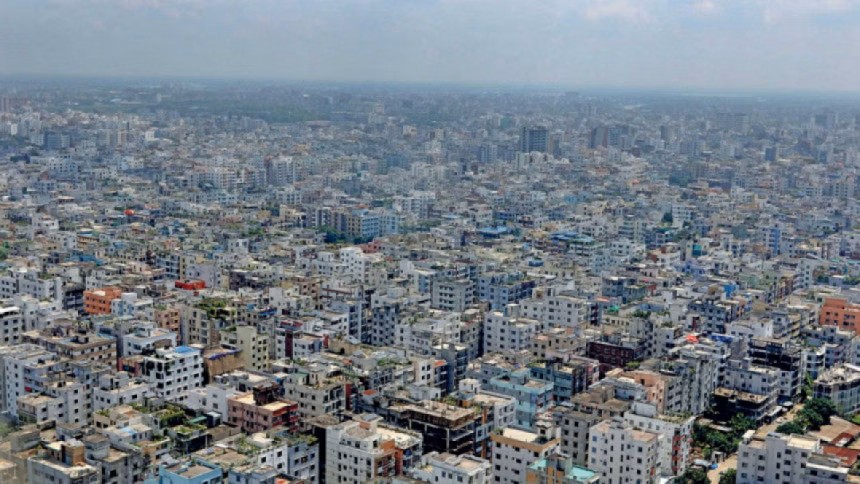A plethora of afflictions is hastening the decay of the once beautiful Dhaka, thereby earning the epithet ‘unlivable city’, to the dismay of those who still love this megacity. It is particularly painful to those who were born and raised in this city in the ‘40s or ‘50s or ‘60s when it was no bigger than a mofussil town. Beginning at the Sadarghat, it ended at the edge of Azimpur. Dhanmondi was still in the dream of the town planners. And that dream, most old timers think, destroyed Dhaka. Today nearly 2 crore people live in Dhaka.
No wonder why the original residents of Dhaka blame those who landed in the city on a misty morning by a passenger launch or a train and stole their very own Dhaka from them. About 50% of the residents of Old Dhaka now are actually outsiders. Since the ‘40s, the population of the small city started to swell within decades and along with them roadside garbage began to overflow in ghastly proportion. Today Dhaka’s soil and air are toxic to the point of no return. Its water is poisonous and unfit for consumption unless chemically treated.
The city has grown haphazardly both horizontally and vertically with no long-term planning. A bird’s eye view will reveal that the city looks like a jigsaw puzzle gone haywire. The once famous canals, ponds and other waterbodies are all filled up and as a result excess water that accumulates on the roads and streets after a rainfall cannot find ways to clear out soon.
The malady of the city has grown bit by bit over the decades thanks to negligence and incompetence of the city fathers. The Dhaka Improvement Trust (DIT) of the pre-liberation era and Rajuk in the post-liberation period was run by incapable people with little knowledge of how to plan a modern city. Most of them came from their ancestral villages with no concept of modern living in a high-rise building. They were more apt in taking bribes to get a building plan approved by the bosses than solving a real problem. The results of the blatant corruption of the two offices are now starkly evident. Today, we can see residential houses, schools and small factories existing side by side in a two square kilometer area.
Once Old Dhaka was known for its many narrow lanes, but now one will find similar narrow lanes in the residential areas built in the ‘80s and ‘90s and even later where no house owner has left empty space on four sides as per the regulations. The lanes are so narrow and winding that in case of a fire incidence no fire-fighting vehicle will be able to enter them and also there is no fire escape stairs in any house. Many business houses, warehouses and shops are located in various residential houses in those narrow lanes, which draws hundreds of rickshaws every hour in search of passengers.
The traffic woe of Dhaka is legendary. With one of the most inefficient traffic systems in place, road congestion remains a daily phenomenon. On a given day, a 30-miniute journey to office may end in 1.5 hours. One will not be surprised to see derelict buses plying on roads under the very nose of the traffic police.
The main city roads remain clogged with thousands of vehicles of various denominations from dawn to dawn. As a result, millions of gallons of petrol and octane burn every month in never-ending traffic jams as vehicles remain stand-still for hours together. This leads to worsening of the air quality of Dhaka.
There is also much to say about noise pollution in Dhaka, which also contributes to rendering it unlivable. Though decibel limits are mentioned in official books, no vehicle driver abides by the law. As a result, high pitch horns and other sounds enter our battered ears from morning till midnight. Private cars violate this law with total impunity.
One has to review the work of the numerous real estate developers to assess how they have contributed to changing the visage of Dhaka in the last three decades. While some projects have enhanced the beauty of new Dhaka, most others have done just the opposite. The main allegations against them are filling up of the canals and low-lying areas. As a result, excess water cannot move out of the city after a little rain. Some of these companies are now trying to shift business outside Dhaka. We can see signboards of real estate companies in waist-deep water in the countryside, alluring customers with lucrative offers.
This writer believes Dhaka’s fate is sealed already. No sign of redemption anywhere. Earthquake experts predict widescale destruction of the city in case a massive quake will hit it. Can we abandon Dhaka, like Emperor Akbar had abandoned Fatehpur Sikri?


